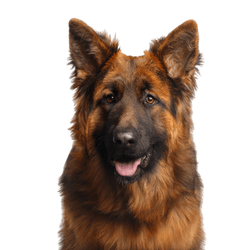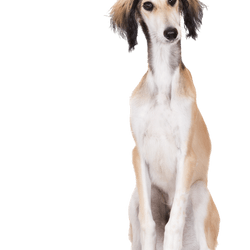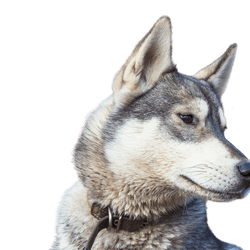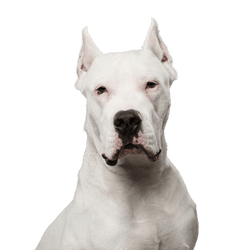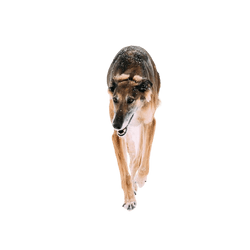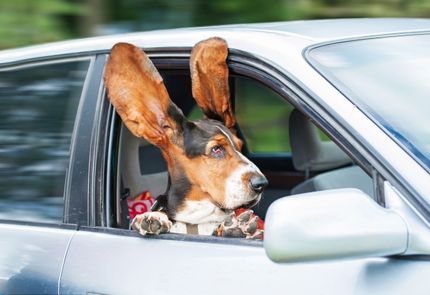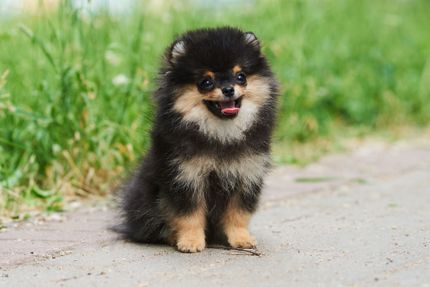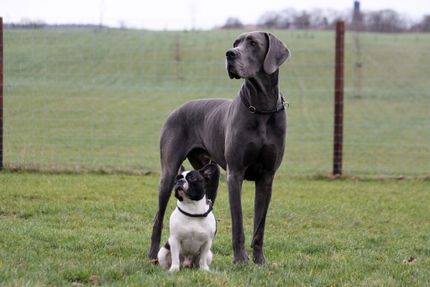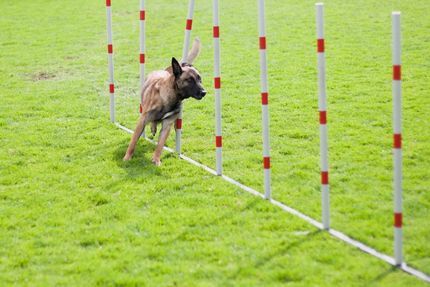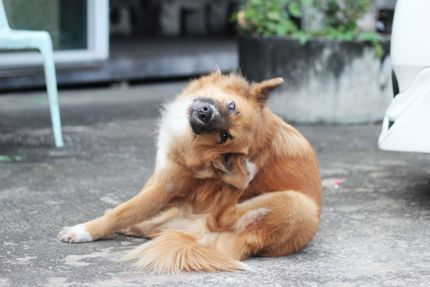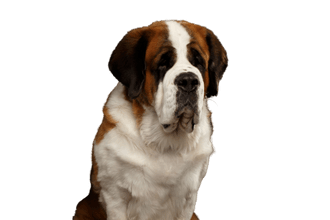
Saint Bernard Breed description: Character & Co
Saint Bernard
Facts & Origin
The Saint Bernard is large and heavily build. Despite its looks it is a gentle and calm family dog that gets along well with children. St. Bernards need a lot of space and sufficient exercise. They are not suitable as residential or city dogs. They need consistent training and a high level of loving care.
From guard and rescue dog to family's favourite: the Saint Bernard dog
The St. Bernard dog is also known as the Bernhardiner. Its origin lies in the Swiss Alps. It is the national dog of Switzerland.
On the Great Bernhards, a mountain pass in the Valais Alps, Augustinian monks founded a hospice for travellers. It offered a safe place to stay overnight and food for travellers. From about the 17th century onwards, they used ancestors of today's mountain dogs as transport, rescue and guard dogs. In the monastery's own breeding, the former farm dogs developed into the St. Bernhards dog with its appearance we know today. They were called "Barryhüng", bear dogs, and weighed a maximum of 50 kg. Because of their agility, endurance and excellent scenting ability, they became famous avalanche dogs. The best known is "Barry". It is unclear whether he might just be fiction. The St. Bernard dog is said to have saved the lives of 40 people who were lost or buried in avalanches. From the 20th century onwards, they developed into popular family dogs. They were bred for size and lost their agility. As rescue dogs they were replaced by other dog breeds. Due to its build and caution towards strangers, the St. Bernard is occasionally kept as a guard dog.
St. Bernards are listed by the World Dog Federation Fédération Cynologique Internationale (FCI) under FCI No. 61. In Group 2 "Pinscher and Schnauzer, Molossoid and Swiss Mountain and Cattle Dogs" they are assigned to Section 2.2 "Molossians, Type Mountain Dogs".
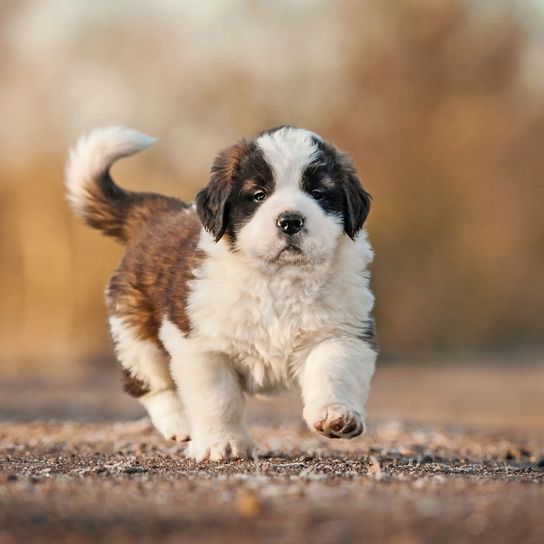
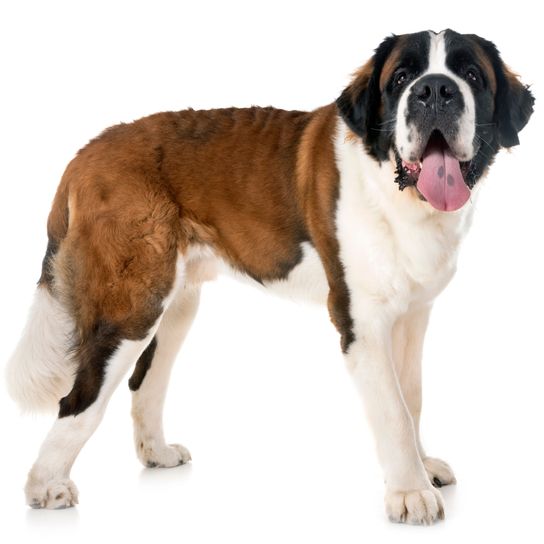
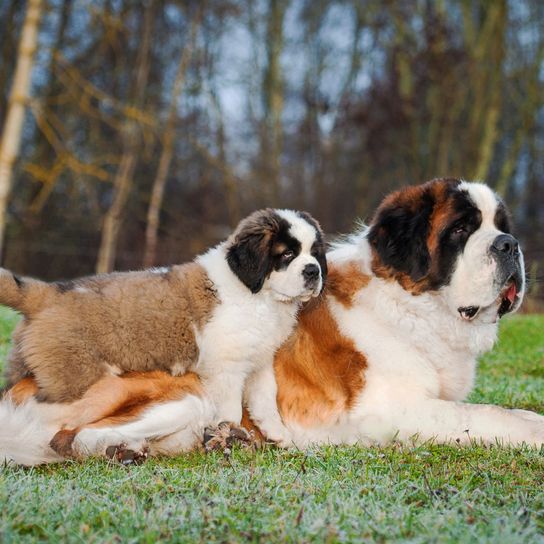

| Alternate Name | Bernhardiner |
| Origin | Switzerland |
| Life expectancy | 8 - 10 years |
| Care requirements | high-maintenance |
| Activity level | average |
| FCI group | Molossian type |
| AKC group | working group |
| KC group | working group |
Saint Bernard mixes
Attitude, character and temperament of the breed
Among the positive characteristics of the St. Bernard are
- gentleness
- attachment to their owners
- intelligence
- need for balance
- loyalty
The sensitive giants occasionally tend to be stubborn. Saint Bernards need a loving and consistent upbringing. They react with aggressiveness only in exceptional cases. They would protect their family until exhaustion. Due to their good-natured character, they are suitable as playmates for children. Ball games are among their favourites. You should make sure that small children do not accidentally end up underneath the massive body of the dog while playing around together. St. Bernards need a lot of exercise due to their size, but they love long, leisurely walks. In winter they like to play around in the snow. A rural environment is ideal for the large St. Bernhard. They are well suited as farm dogs.
Character
Usage
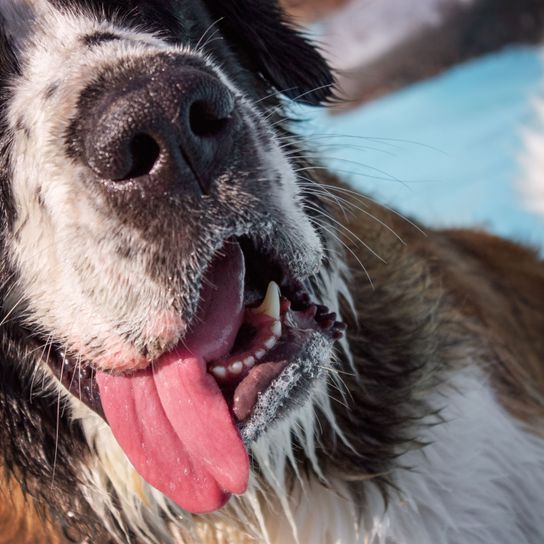
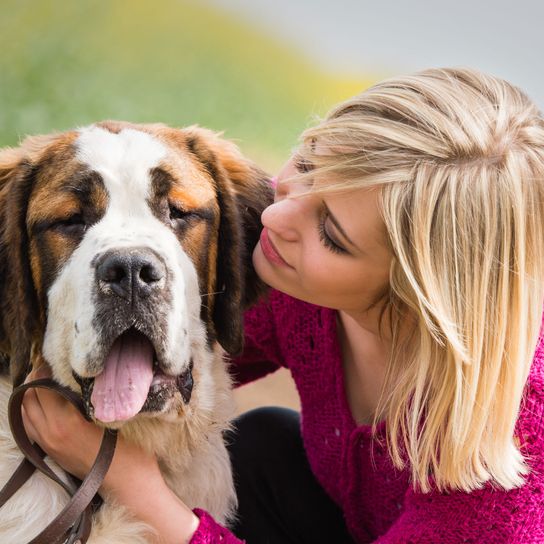

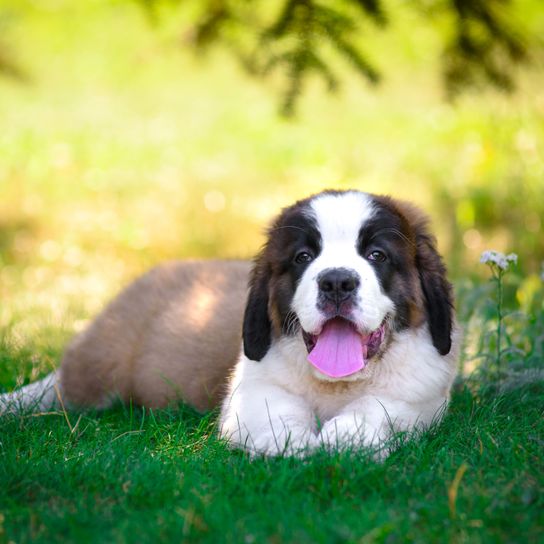

Health and breeding information
Typical diseases
Saint Bernards are susceptible to developing:
- Hip joint dysplasia
- Bone cancer
- stomach twists
- Hanging eyelids
The eyes, ears and claws of the St. Bernard should be checked and groomed regularly. Typical are diseases of the eyes and skin as well as tartar. A balanced diet should be ensured when feeding. A combination of meat and vegetables with many vitamins and minerals is ideal. Saint Bernards tend to eat too much and put on weight easily. Feeding only dry food in combination with the additional water required can increase the risk of a twisted stomach. A regular resting period after the meal should be provided.
Saint Bernard breeding
When breeding you have to insure to only breed with parents whose pedigree is known to birth healthy puppies. Both parents must be tested for hip joint dysplasia in order to exclude the possibility of the offspring suffering from this disease.
Buying a St. Bernard dog
If you want to buy a Saint Bernard puppy from a good breeder, you have to calculate costs between 950 and 1300 Euros. With the follow-up costs you have to consider that with a St. Bernard everything is a little bit bigger and larger quantities: the collar, the kennel and the amount of food.


Appearance and coat
Long, slender legs carry a massive body with a large, slightly forward-curved head with a broad skull and medium-sized, high-set hanging down ears. The nose is broad and angular. The bridge of the nose is straight with a slight groove. The well developed eyebrows and oblique wrinkles over the gentle brown eyes give the dogs a melancholic expression. The strong tail hangs down when resting. The topline is horizontal, the back is firm and broad.
On legs, underbody, chest and face the coat colour is white. At the head and back the Berhardiner is multi-coloured with red, white and brown fur plates (plate dogs) or a continuous coat (coat dogs). The face is characterized by a symmetrical make. The smooth coat is dense with abundant undercoat and shiny. It is bred in the expressions short stick hair or long hair. The coat should be brushed regularly.
Size with male and female dog
The Saint Bernard belongs to the largest dog breeds in the world. Males reach a height at withers of 70 to 90 cm, bitches usually from 65 to 80 cm. Especially large bitches reach a height at the withers of up to 85 cm.
The Saint Bernard - A heavyweight
The weight of St. Bernards is between 55 and 90 kg, in individual cases with particularly large males even about 100 kg. The space requirement in house and car is accordingly large. The heavy dogs need a soft bed to avoid pressure points and pain.
Short age expectation
Saint Bernards have a low life expectancy of 9 years. Only every fifth St. Bernard reaches an age of over 10 years.
| Fur length | medium |
| Fur | flat coated |
| Ear shape | - |
| Tail | fanned out |
| Anatomy | strong |
| Size ♀ | 65 - 80 cm |
| Weight ♀ | 64 - 120 kg |
| Size ♂ | 70 - 90 cm |
| Weight ♂ | 64 - 120 kg |
| Suitable For | - |
Colors


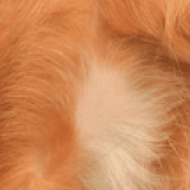



Known Diseases
Epilepsy
Definition: Dog has epilepsy if, for example, at least two epileptic seizures occur more than 24 hours apart.
Cancer
May be common in older dogs.
Skeletal disorders
IPA, FPC and OCD occur in dogs at four to five months of age during the most severe growth spurt.
FAQ
-
Can yes, should no. A St. Bernard is one of the largest dog breeds and therefore needs space. If you have a large apartment and spend a lot of time outdoors with the dog, it can of course work. However, it is recommended to own a house with garden to keep this large animal species-appropriate.
-
Yes, a Saint Bernard is an ideal guard dog.
-
A St. Bernard puppy costs about 1500 Euro.
-
No, a Berhardine dog is not dangerous and is not considered a list dog.
Other large dogs
Useful Articles
You can find articles that might interest you in the dogbible blog to match your favorite breed.
Visit our magazineto stay up to date on dog trends.
To find out more, view our Privacy Policy
Find here the breed that suits you and find out what character traits it has. Here you can also learn more about the origin, size and weight of your favorite breeds.
Matching your favorite breed, you'll find articles that might interest you on the dogbible dog blog.
3 tips for snowshoeing with dog
Kong filling - recipes for really tasty Kong fillings
Rabies in dogs - rabies vaccination and signs that your dog is affected
Popular dog breeds - these are the 15 most common dog breeds in Germany and Austria






